|
FONTS & GIFs.
Cyrillic Fonts. Animation Factory. OTHER WEBSITES WITH MESSAGE BOARDS. 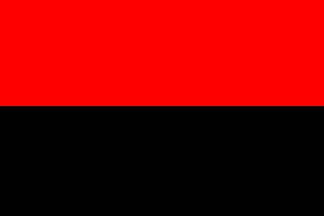
MacedonoBulgarian & Bulgarian Discussion Boards.
Visit VMRO's Two Message Boards.
Visit the St. George's Day Message Boards.
Visit the Macedonian Message Board with both Cyrillic and Latin.
Visit the Bulgarian Message Board with both Cyrillic and Latin.
Visit BOL Forums.
Visit the Banitsa Forum.
Visit Bulgaria Discuss Forum.
Visit the Vardar Macedono-Bulgarian RADKO Forum.
Visit the NEW Macedono-Bulgarian RADKO-Varna Forum.
Visit the Macedonian American Friendship Association Forum.
Visit the Tanusevci Forum, focuses on the Macedonian/Albanian conflict in RoM.
Best of soc.culture.bulgaria
Visit the MigNews Message Boards.
Visit the Bulgaria: Now And Forever Forum.
Visit the Bulgaria Genealogy Forum.
Visit the Macedonian Genealogy Forum Forum.
Visit Jill Jugloff's Genealogy Macedonia Forums.

Bulgarian Moscow Embassy Forums. 
Volga Bulgarian Websites & Boards.
Visit the Bolgar National Congress. Visit their Pan-Bulgarian Boardhost & Network54 Message Boards.
Visit Perun's Great Bulgaria Website and Forum.
Visit the website Idel-Ural and its forum. 
Forums about Royalty & History.
Visit the European Royals Message Board.
Visit Netty's Royal Message Board.
Visit the Imperial Russia Message Board.
Visit the Forum about the Roman Empire.
Visit the All Empires Message Boards. 
International Affairs Message Boards. Visit the politicsforum.org (Warning; it's leftist!).
Visit FreeRepublic.com an (anti-Slavic) American Cowboy Forum.
Visit Serbian Underground Cafe' "At your own peril..."
Visit the old Current World Events forum, moderated by Kamil (Volga Bulgarian) & the new forum.
Visit the Balkan Conference Group Forum.
Visit the World Travel and Global Issues Forum.
Visit the PRAVDA.ru Forums. 
Judical Affairs Message Boards.
Visit the Milosevich Trial Discussion Forum. Message Boards on Religion. Visit the AntiJihad Forum.
Visit the Jerusalem Post Message Boards.
Visit the Muslim Fundamentalist Message Boards (No, really!). 
Forums about Military & War.
Visit the Skalman.nu Forum.
Visit the Russian Fighter Plane Forum.
Visit the Russian Military History Forum.
Visit the Military Forums.
Visit the JPs Panzers Forums.
Visit the Strategy Page's Discussion Boards.
Visit Scramble's Discussion Boards.
Visit Skalman's Military History Discussion Boards.
Visit RBF Military Forum.
Visit the Austro-Hungarian Land Forces Discussion Forum.
Visit the The World At War Forum, Discussion about Bulgaria.
Visit the Warfare HQ Discussion Forums.
Visit Military.com Discussion Forums.
Visit Aerospace Forum and the Modern Tanks Forum
Visit the Aerodrome Forum.
Visit the World Politcs and military armed forces disscussion Forum. Slavic Message Boards & "other."
Visit The Slavic Community Message Board.
Visit Russkii Voin's Slavija Forum, Bulgarian & Croatian nationalism is a taboo here.
Visit Borka the Polak's parody of Slavija, the Anti-Slavija forum, very funny!
Visit the forum about Russia, Bulgaria, Macedonia and other slavonic countries.
Visit the Slavonic forum.
Visit the Ukraine.com forum. 
Links to the Macedonian self-denial websites and message boards. In the 19th century the Ottoman Empire declined in power. In the Balkans, the last foothold of the Turkic armies was located in a region that in antiquity was called the Kingdom of Macedonia. In the west rose the admiration for the Christians who struggled under the Turks oppression, especially for the Greeks. It seemed appropriate for the nostalgic westerners to name the Turks last possession in the Balkans with the name Macedonia. Macedonia had many minorities, most of whom wanted to unite with a neighbouring country. The Bulgarians wanted a unified Bulgarian state like the one they had been guaranteed by the Russians in the Treaty of San Stefano. Fate had it that most Macedonian Bulgarians came under Greek and Serbian domination; they struggled to preserve their identity. Todays Republic of Macedonia was one of the states in Yugoslavia. Marshal Tito faced the pressure that the Bulgarian people should unite with the Bulgarian state. Tito refused; he required a strong state so he attempted to stamp out nationalism in all of Yugoslavia. The Bulgarian minority was persecuted and went through a crude national experimentation that was intended to foster a new Slavic identity. Titos brainchild was nothing less than rewriting the Bulgarian language with a Serbo-Croatian typewriter. Bulgarian literature and history remained but the word Bulgarian was erased wherever it could be found and it was exchanged with the word Macedonian. Thus Tito could preposterously claim that the Bulgarian minority was really another people and was an essential part of the Yugoslav Federation. In the 90s Macedonia became independent for the first time, the newfound liberty gave birth to a free society where the citizens tried to find their roots for themselves, some have chosen to acknowledge their Bulgarian roots and others have hijacked ancient Macedonian history that rightly belongs to the Greeks. Visit Bill Nicholov's NEW Macedonia for the Macedonians Forum.
Visit the craziest Bukefalistic Forum on the Planet! A joke :)
Visit Laci, Viktor MAKEDONEC & amynta's "free" Forum.
Visit the Makedonija/Macedonia Forum.
Visit the makedonija dc Boards.
Visit the makedonija/ Forum.
Visit the rmacedonia/ Forum.
Visit the "Pirin" Yugomaniac Forum.
Visit the "Aegean" Yugomaniac Forum.
Visit the Banitsa Message Board. 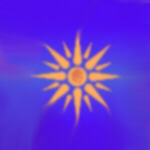
Links to the Greek Macedonian websites and message Boards. Greek people have had a presence in Macedonia ever since antiquity. Their interaction with the Slavs there has certainly had its ups and downs. Both factions face the trial to find a way to coexist in this region on equal terms. Visit Macedonia: 4.000 years of Greek history, culture and civilization. Here is the older forum. . 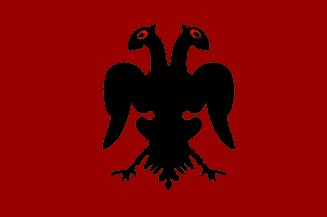
Struggle for autonomy.
by Jaume Oll?
Albania was a Turkish possession from the 15th century. In the 19th century century, the Albanian independentist circles used a red flag with the Byzantine bicephalous eagle, supposedly used by the Albanian medieval hero Scanderbeg (known in the West as George Kastrioti), and never forgotten in Albania. The above [chicken] image is a reconstruction. Links to Albanian Propaganda. Albanians are the most intolerant people in Europe, they show great solidarity to each other when they come together to demand more rights. The common sign is always that Albanians never create a forum together with other minorities that they live with. Is it phobia that others will publicly address western media that there are alternatives to the Albanian irredentism? Visit the UCK/NLA website from Tetov-O.
Visit the AACL, Albanian American Civic League.
Visit the Alb forum. 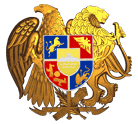
Links to Armenian, Kurdish, Greek and other information about our two-faced southEastern neighbor, his past and current misdeeds. Take a highway to Man's darkest corner of his heart, visit Turkey and the world of its people. How is it that the Turkish state, which never was part of the Warsaw Pact wont join the EU any-time-soon when those States who were part of the Soviet Union's sphere of influence are about to? The outcries against the chauvanism that have bathed the Balkans and the Armenian People in blood, demand an end to Genocide denial from the Turkish state and its fascistic dictatorial Generals. This is the third Millenium, let it be one of peace by admitting past wrongs and start over. 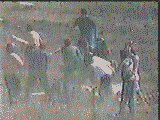
Discover the Republic of Turkey, visit this Armenian Forum.
Visit the Armenian Diaspora Free Forum.
Visit the Armenian Highland website and its forum to talk to our friends.
Visit the Ottomans Forum.
Pictures of the armenian genocide.
News regarding Human Rights in Turkey.
Read about the Survivors from the Maraghar Massacre. The ethnic cleansing of the Armenians in Azerbaijan (1987-94).
Visit the TURKISH CRIMES AGAINST HUMANITY website and Forum, make a NOTE about 'The Bulgarian Atrocities' page.
Visit the American Kurdish Information Network AKIN website.
Visit the Kurdish Struggle website & look at the Kurdish Genocide Photos. The Kurdish Manifesto-Abdulah Ocalan, Terrorist or Hero? Read here.
See MAP of Kurdish Ethnic Spread , which crosses International borders.
Visit the Human Rights ACtion website about Turkish evil deeds.
Visit the Turkish Crime of Our Century website.
Visit the Holidays in Turkey? website.
Visit the Turkish Violations of International Law website.
The Treatment of the Armenians in the Ottoman Empire.
HITLER was inspired by the Armenian Genocide!
TURAN, Turkish Fascist website. 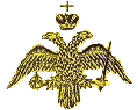
Links to proByzantine websites and message boards. From what I gather, they want a revival of the old Byzantine Empire with Tsarigrad/Constantinople as the capital, spiritual and ideological center. They are very proSerbian, unfortunaly there is no information yet if those sites are Bulgaria-friendly. We can hope that in the future there will be websites that proclaims a Byzantium Confederacy for our all common interests.
It is clear that the European Union is good at solving economies but is very undemocratic and anti-NationStates. Could a Balkan League be an answer? Remember that Khans & Tsars longed to live in a state of Greeks and Bulgarians as equals. Even our Prime Minister (the protector of the Bulgarian Orthodox Faith), Tsar Simeon the II's German grandfather, Tsar Ferdinand, revived this school of thought. Will the Balkan Christians save themselves and not be swallowed by islam & liberalism because they solved their differences? Stay tuned folks! Visit the NeoByzantine website and forum.
Visit the Byzantine Alliance website and its message board, the Orthodox Front. Links to Balkan websites & message boards. Please visit Chuvar's Balkanika Forum. 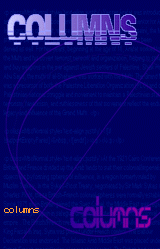
Write Columns and essays at other websites. To be considered for publication on serbianna.com, please send your article as a regular email to: columns@serbianna.com Please me mindful that extremist articles and/or derogatory, offensive, unreasearched, or otherwise offensive writing will not be considered. Further, articles and writing that is framed as an "open letter" to someone or is a direct and narrow opinion on an already written piece is discouraged. Discussion on such matters should be directed to our Discussion Forum. We do not accept attachments in the initial submissions. ESSAYS MADE WITH DEDICATION AND CONCERN. ALL ARE FREE TO WRITE AN ESSAY ON SUBJECTS CONCERNING OUR PEOPLE, EMAIL ME AT mixile@yahoo.com OR WRITE AT THE MACEDONOBULGARIAN- OR CHRISTIAN BOARDS. V E L I K I S M. A Synopsis of the Historical Development of the
Slavonic people of Macedonia-Moesia-Thrace.
By Kamen Vardarski
An objective, balanced and organic analysis of the native Slavonic speaking population of Macedonia-Moesia-Tharce reveals them to be on the anthropological grounds of philology, culture, history and race composing one unique historical ethnic group mosaically accumulated through a long natural process of the blending of many peoples which has been the characterising feature of their land since time immemorial. Their homeland of Macedonia-Moesia-Thrace is an ancient inhabited land witness to the settlements of scores of diverse peoples who became the destined building blocks of the modern Slavonic speakers. The earliest recorded dwellers classified as Thraco-Illyrians, were the Thracians, Illyrians, Macedonians, Moesians, Paeonians, Tribalians, Dardarnians and others who were distinguished from each other through language, religion and culture existing in most instances separately although trade played a large role between them facilitating the early exchange of peoples through migration thus becoming the typifying nature of the land for the coming centuries. This early ethnic interaction was coupled with the injection of other peoples into the fast becoming rich milieu resulting from parts of the land being included in foreign empires, which was a factor of the land being a key trade route between Europe and Asia and also the local populations taking part in foreign wars saw foreign soldiery, settlers and slaves mixing with the local populations turning the land into a confluence mixing point for many tribes. With the descent of Roman rule upon the land came a new infusion of people into the cauldron as well as inter-tribal relations being enhanced through the introduction of uniform rule on the land- a defining prerequisite as a conforming factor. Encouraging even greater mixing between the inhabitants, Roman rule would eventually bring modern civilisation and a legacy of a united religious heritage in contrast to the formally fractured religious practises. Roman soldiers and administrators were deployed throughout the land instigating a gradual population exchange.
During this period, major infrastructure projects were undertaken and carried out with roads and water supply systems built, fortifications erected, new cities founded and a common legal system introduced. This activity, designed to pacify the ruled populations, enabled the acquiescent settling down of the inhabitants prime for interweaving due to a feeling of collectiveness imposed by the foreign rule which created the condition, coupled with other factors, for the steady adoption of a Latin dialect as the lingua franca of the land and for some of the inhabitants it was at the expense of their mother tongues. During this period of relative stable development, a variety of new peoples began migrating to the land both from the empire and outside of it, specifically Central Europe and parts of Asia which included Huns, Celts and Goths adding their own particular contribution, through their mixing with the inhabitants, to the rich racial coalescing evolution of the modern Slavonic descendants. The most important migrations of the settlers that were to feature strongly in the eventual unified compilation of the inhabitants were the Slavonic and Bulgar tribes. Migrating in several directions outward from their homeland in the Dneiper region between the Carparthians and the Vistula, the Slavonic tribes arrived to the land in waves beginning in the sixth and extending into the seventh centuries AD. As the Slavs, meaning enlightened ones, began to populate the fertile plains in large numbers, a minority of the indigenous populations migrated to the hillier confines of the land away from the reaches of assimilation where they would endure for millennia.
The various tribes of the new comers gradually submerged the remaining inhabitants in the fields and valleys. The absorption of the indigenous inhabitants by the Slavs provided the groundwork for the progressive unification and evolvement of the previously divided peoples. This evolution would be compounded by the next wave of migrants closely following that of the Slavs- the Bulgars, who would be the most important factor in the eventual final molding of the people of Macedonia-Moeisa-Thrace into a single tribe, a process which tentatively began centuries earlier. The Byzantium Empire after having lost control of the Balkan lands, which instigated in effect the Slav migrations, undertook a re-conquering campaign in the Balkans. Seven of the fractured tribes of the Slavs inhabiting the Moesia region united against this threat and entered into an alliance with the Great Bulgarian state based around the Volga against the empire which would lead to the migrations of the Bulgarians into the lands and the foundation of a state that would be recognised by Byzantium. The minority Bulgars, through their leadership effort in the war against Byzantium in coalition with the Slav majority, managed to assert their oligarchic rule over the Slavonic mass of the land as a just desert that was as a result of the Bulgar's superiority in social and military organisation in comparison to the Slavs.
As the extension of the Great Bulgaria state into the land was consolidated over the coming years through the Bulgar rule, the Bulgars gradually began mixing with their Slav allies and eventually spread to the other regions of the Slavonic populated region from their initial settlement regions as a natural process that enabled the growth of the Bulgar rule across the land. In an immense historic move, the Bulgar ruling elites adopted in favour of their own language the Slavonic speech of the inhabitants as the official and lasting language of the land, resulting in the first Slavonic state. This period of Bulgar rule eventually saw an overwhelming influence of the Slavonic peoples as well as their incorporation into the ruling circles that would become centralised. This first Slavonic state in the world would have a tremendous impact both within and without the Slavonic world with achievements including the establishments of the first Slavonic: church; monarchy; and including as importantly; learning institutions.
The defining recognition point in the unification of the people into a single unit came with the adoption by the inhabitants of the Bulgar tribal name. The practise of acquiring a name from a ruling or influential people has been an infrequent feature in history although it's custom is testified by the two prominent examples of the French and Russians respectively who adopted their names from other tribes. The inhabitants maintained this Bulgar ethnic name through force of habit for over a millennium as a delineation from other people, as well as being defined by it by others, although it weakened and or was not strong in some regions as a consequence of certain factors primarily as a result of the modern ethnical identification era not beginning until well after the middle ages and thus such tribal identification was not a strong cultural practise of the day to day existence of peoples. The Bulgars eventually dissolved within the sea of the Slavonic peoples and with the exception of some intermixing occurring through the arrival of new migrants during the next five hundred years of foreign rule, became the last major contributing factor together with the Slavs to the steady broad racial converging development of the modern Slavonic speaking inhabitants of Macedonia-Moesia-Thrace as an anthropologically unique ethnic group and inheritors of a glorious history.
End note.
As a conclusion based on the amalgamation of the historical inhabitants of Macedonia-Moesia-Thrace, Velikism has it's genesis in the Slavonic Macedonian Diaspora in the late 1990s although Velikism as a historiography predates it's officialisation. As a well founded observation based on common sense, it is a balanced historical deduction and an acknowledgment that racial/ethnic intermingling took place in Macedonia-Moesia-Thrace as the natural order of human society for countless centuries and that the modern Slavonic inhabitants of the land are the culminating product of the stratal fusion between all the historical inhabitants of the land. As such, Velikism is the solid middle ground among the main historiographical theories dividing these impressive people as it rationally combines the basic premise of each of the ideologies.
These ideologies of Slavicism, favouring descent from the Slavs, Bulgarism, favouring descent from the Bulgars, Macedonism, favouring decent from the Macedonians, and Thracianism, favouring descent from the Thracians, are respectfully, by a critical evaluation, revealed as illusive views of history without justifications based on ill-conceived romanticisms contrary to history and logic since each crucially minimalises or outright denies influence from other historic inhabitants of the land. History indicates that the intermingling of peoples has been an unavoidable occurrence from the dawn of time, through war or peace, and that especially in Macedonia-Moesia-Thrace, where many migrations of people have been frequent, wholesale depopulations rare and, crucially, complete segregation beyond reason, one must accurately conclude with the only fundamentally reasonable and sound observation that the Slavonic speakers of Macedonia-Moesia-Thrace are the final interwoven tapestry of all the historical inhabitants of the land comprising a Thraco-Illyrian base significantly and alterably added to by Slavs and Bulgars with sprinklings of important contributions from other peoples.
Being thus an outcome of the interaction and ensuing emulsification of the historical inhabitants of the land, the Slavonic people cannot and must not base their identity on any one tribe of their forefathers and equally must not assume as their ethnic name the tribal name of either of the peoples constituting their glorious heritage. They are neither Thracians, Illyrians, Moesians, Macedonians, Paeonians, Slavs nor Bulgars, but are rationally verifiable in part descendants of all these historical inhabitants of the land. They justifiably should reflect their unique mixed heritage and glorious history with their own deserved name of Veliki, Great People, and their homeland of Macedonia-Moesia-Thrace should be known as Velika, Great Land, to indicate the great mixing of people that took place over the millennia and the momentous achievements accomplished.
Selected Bibliography:
A Concise History of Bulgaria, R. J. Crampton; A History of Medieval Europe, R. H. C. Davis; A History of the First Bulgarian Empire, S. Runciman; An Introduction to Roman Law, B. Nicholas; A Text-book of Roman Law from Augustus to Justinian, 3rd ed, W. W. Buckland; Bulgaria Illustrated History, B. Dimitrov; History of Attilla and the Huns, E. A. Thompson; History of Macedonia 1354-1833, A. E. Vacalopoulos; History of the Ottoman Turks, E. S. Creasy; Huns, Vandals and the fall of the Roman Empire, T. Hodgkin; In the Shadow of Mt Olympus, E. N. Borza; Lower Moesia and Thrace in the Roman Imperial System AD 193-217/218, D. Boteva; Macedonia and Greece in Late Classical and Early Hellenistic Times, E. Badian; Macedonia from Phillip II to the Roman Conquest, R. Ginouves; Macedonia, Thrace and Illyria: Their Relations to Greece from the Earliest Times down to the Time of Philip, Son of Amyntas, S. Casson; Macedonia Yesterday and Today, Giorgio Nurigiani; Macedonia Yesterday and Today, J. & M. Pavlovski; Slaveno-Bulgarian History, P. Hilendarski; Slavonic Ethnology, P. Safarik; The Birth of the Middle Ages 395-814, H. St L. B. Moss; The Byzantine Commonwealth, D. Obolensky; The Chronicle of the Slavs, H. of Bosan; The Decline and Fall of the Roman Empire, E. Gibbon; The Early Slavs: Culture and Society in Early Medieval Eastern Europe, M. Barford; The Illyrians, A. Stipcevic; The Illyrians, J. Wilkes; The Later Roman Empire 294-602, A. H. M. Jones; The Macedonian State: Origins, Institutions and History, N. G. L. Hammond; The Making of Byzantium 600-1025, M. Whittow; The Making of the Slavs: History and Archaeology of the Lower Danube Region, C. 500-700, F. Curta; The Proto-Bulgarians: Pre-History of Asparouhian Bulgaria, V. Giuzelev; The Roman and Early Byzantine Fortifications of Lower Moesia and Northern Thrace, M. Biernacka-Lubanska, The Roman Empire, M. P. Charlesworth; The Slavs in European History and Civilisation, F. Dvornik; Thrace and the Thracians, A. Fol; F R E E M A C E D O N I A The Kamikaze Attacks on the United States of America.
Sheer Western Hypocrisy.
The three successful terrorist attacks, including the fourth unsuccessful one, committed in the US against civilian and state targets represent an unforgivable two faced hypocrisy on the part of the western world and highlight a clear condemnable unfeeling attitude in respect towards other nations who are victims of such incidents. Leaders of the west today are pouring fourth shock, anger and intoleration against that which has occurred, strongly pronouncing retribution without any hints whatsoever at a compromise or even accommodating the motivating factors of the perpetrators behind these attacks. The response is one of absolute hostility towards the violence and that which it represents. One may say that it is justifiably so. That it is barbaric in the extreme and any contemplations of allowing what has been committed to sway government policy or even to change opinions on the established views of the western leaders on any issues would be unconscionable. It would amount to an approval of the committed savagery. This argument would be considered as natural common sense. However, this argument is blown out of the water lacking in credibility on the part of the western world and exposes an unacceptable disgraceful hypocrisy. A hypocrisy as evident as the fact that the twin towers of the world trade centre are no longer existing on the New York skyline. This is born out in full view to the entire world when an analysis is made of what has occurred in the Republic of Macedonia. It has been the very same players in the west, the same countries which have come out furiously against the attacks on the US who have aided the use of such methods against the peaceful democratic Republic of Macedonia and have forced the democratically elected government of that country to not only enter into negotiations with terrorists and to give way to the murderously supported demands but also have successfully prevented the country from fighting against them through numerous channels including memorably at Arachinovo when they, the west, these pugnacious hypocrites that they are, came to the rescue of the invading terrorist forces and bused them to freedom away from the reaches of justice and allowing them to carry on in their evil. It is the very name Arachinovo which will go down in history as a symbol of western hypocrisy in relation to the sanctioning of brutal methods against freedom, against history and against justice. Arachinovo represents the abject failure of the callous charade that is the west. Crocodile tears that are being shed for the attacks in the US are tears coming from these very same people who forced the government of the Republic of Macedonia to comply with the the hi-jacking mutilators of peace, freedom, democracy, history and justice. The world sees brilliantly this hypocrisy and for all upholders of justice, for those who stand for freedom, the west has been the deserved receiver of its very own actions around the world and especially for that which it committed in the Republic of Macedonia. To play with fire is to be burned. It is of no use complaining when you have been affected by that which you have supported in other countries, for it is absurd when a serial arsonist mourns his own home catching the flames of a fire- a fire that which he fuelled and actually prevented from being extinguished. The sympathies of the Macedonian people collectively, as the victims of such vile acts, is with the innocent victims and our heartfelt thoughts are with their families, friends and loved ones, who we can first hand relate to, in stark contrast to and independent of, the utterly contemptous malice shown against us the Macedonian people by the victim's leaders who in co-alition with other western leaders piloted the airplane of immorality and indecency filled with the fascist terrorists from Kossovo and deliberately and coldly aimed and smashed it straight into our dignity as a people within our ancient homeland.
- Vasko Za moia priatel Tsar Samuil. by Sevastocrator Tihomir Breznyakov
I read your last posting meant for me. The questions you asked me about have been of interest. Unfortunately not much was ever published in Bulgaria on the subject, perhaps because it is either insignificant or the lack of archeological evidences.
It is well known that the Slavs splitted off into three major sub-groups. The western, southern and eastern ones. Firstly, the southern Slavs bulked in the former Roman province of Dacia. This is today's lower portions of Romania. They crossed Dunabe for loot and pillage and after the raids turned back to safety. Some of the squads liked the fertile fields of Moesia and decided to camp over the winters on Byzantian soil successively several years in a raw. Little by little, most of the Dacian Slavs descended to Moesia and mastered the depopulated lands. We cannot exactly judge what was their number in the beginning of 7-th century, but after the defeat at Ongula, the Byzantian scouts reported of "sea of Slavs." That is why the military forces the Greeks deployed in the delta of Danube were debarked. Passing through the Balkans would lead to inevitable clashes with the Slavic new-comers. So, most of the Bulgarian Slavs who arrived in our most-beloved Motherland came down from Dacia.
The Proto-Bulgars had intensive contacts with the eastern Slavic groups for long, long time ago. Perhaps in the beginning they fought against each other, but soon after that realised common aims ahead-looting and settling on the Balkans. That is what unified these two completely different tribal units-the long for wealth and lands. Before the foundation of the Balkan Bulgarian State, the Proto-Bulgars penetraded in the Roman provinces of Moesia and Illyria along with the Ante Slavs belonging to the eastern sub-group. This is an evidence of close alliance and mutual understanding. But really these Antes were just a small percentage of the Antes at all, the majority of whom didn't move from their secondary home-lands in modern Baltic countries, Russia, Ukraine, Belorussia. They later participated in the composition of the eastern European nations.
To summarise: the Bulgarian Slavs were both of the southern and eastern groups. But perhaps we are more eastern Slavs rather than southern. And I'm going to tell you why.
These are not lucky coincidences:
Russian Slavic tribes: Severs inhabiting Sul, Desn and Sem regions. Dregoviches living between Pripyet and Dvinoy. Smolyanes-Smolensk city named after them. Bulgarian Slavic tribes: Severyans in Moesia, one of the Seven Slavic Tribes allies of Asparoukh. Dragovotes first around Thessalonaki, then Tetovo. Smolyans in the Rhodopes-Smolyan city named after them.
We encounter also eye-catching similarities concerning toponymes. Pleskov (the former name of Pskov regional center in Russia) and Pliska-the first Bulgarian capital. Preslav, our second capital city has also parallels in Russia-Pereyaslav, Pereslavets. Vinogradets in Bulgaria and Vinovgrad in Russia. Velingrad in Bulgaria and Velnograd in Russia. The list is endless, I'll try to avoid boring you.
The peculiarities Bulgarian and Russian people share cannot be explained just with the close literary development in the centuries, led by Bulgarian cultural expansionism. We were the first to record our own speech in our own letters, to do religious services in our own maternal language, the first who transmitted the P-R-I-C-E-L-E-S-S Byzantian sources to the rest of the Slavdom. Bulgarian liturgical and secular books played basic role in the literary advance of Serbs, Romanians and Russians. Bulgarian was spoken in Romania as late as the XVI century.
But what about Russian and Bulgarian Slavic names? The Balkan Slavic nations possess a much richer variety of the common names'derivative among all of us. Radomir, Radoslav, Radko, Rade, Miroslav, Mirko, Mire, Stanimir, Stanko, Stane, Stanisha, Lyubomir, Lyuboslav, Lyubisha, Branimir, Branislav, Branko, Zdravko, Zoran, Goran, Zhivko, Boyan, Stoyan, Bogdan, Mil/a/en, Milko, Zhelko, Velko, Ventsislav, Venko, Tihomir(hehe), Blazhe, Drazhe, Bozhidar and a-a-all the rest can be met only in Balkan, and some of them in the western Slavic countries. Other group of names like Vladimir, Vladislav, Stanislav, Svetlan, Svetoslav, Svetlozar, Lyudmil and so forth are popular enough both on the Balkans or Russia/Ukraine/Belorussia. This is I think a proof of kinship and comperative sameness. We can also divide the Balkan Slavs in two groups-eastern that includes Bulgaria/Fyrom closer to Russian grammar specialities and Serbo-Croato-Slovenian tight with Czechs,Slovaks and Poles.
Back to the Volga Bulgarians. You know they were severely crushed by the Mongolo-Tatarian forces and their flourishing state declined gradually. They naturally preferred to seek for a more civilised habitation. They found it in the mighty Russian kingdom. Boris Godunov is a perfect example of a Bulgarian who managed to make his way through the politicial and social strata of Russia. A favorite of Ivan IV (Ivan the Terrible), he helped organize Ivans social and administrative system. After Ivans death (1584), Boris became virtual ruler of Russia, ostensibly as regent for Ivans young son Feodor I, who was married to Boriss sister. Boris was popularly believed to have ordered the murder (1591) of Feodors younger brother and heir, Dmitri, in order to secure the succession for himself. Upon Feodors death (1598), an assembly of the ruling class chose Boris as czar. Under his rule the Russian church was recognized (1589) as an independent patriarchate, equal to other Eastern churches; peace was obtained with Poland and Sweden, and colonization of the southern steppes and W Siberia was spurred. Most important, Boris continued Ivans policy of strengthening the power of state officials and townspeople at the expense of the boyars. Yet famine (16024) and popular distrust undermined his support, and when a pretender to the throne appeared claiming to be Feodors brother Dmitri, many rallied to his support and he easily invaded Russia in 1604. Boris died, and his son, Feodor II, was unable to defend the throne against the false Dmitri. Boriss life is the subject of a drama by Pushkin that was the basis for Moussorgskys famous opera.
See? Bulgarians on the top of mighty Russia
Now, about the Finnic blood. Well,living among Finns is a precondition for intermixtures between the two given tribal units. Skulls of Proto-Bulgars found alongside the coast of Black sea claim essential Ugric influence in their physical type-very close to the Magyars in Hungary. Many skulls digged out in southern Russiabore characteristic Iranian bodily marks (due to Sarmathians, Alanians), a third group had the traditionally deformed skulls-sign of Hunnic impact. What I'm trying to say is that it was hard for a nation coming from Pamyr to avoid any blood-line crossing, acquiring racial features of encountered tribal units they experienced solid and durable contacts with.
Nazdrave-e-e-e-e-e-e
Tihomir,Sliven,Bulgaria |



